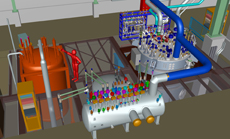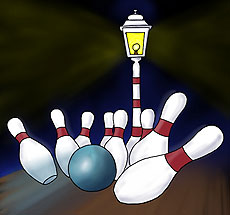|
Have a safe day!
Friday, March 16
2 p.m.
Accelerator Controls Seminar - One West
Speaker: Brian Hendricks, Fermilab
Title: Accelerator Command Language (ACL); A Simple Scripting Language
3:30 p.m.
DIRECTOR'S COFFEE BREAK - 2nd Flr X-Over
4 p.m.
Joint Experiment-Theoretical Physics Seminar -
One West
Speakers: Rick Cavanaugh, Fermilab/University of Illinois at Chicago
Title: Highlights from Recent CMS Results
Monday, March 19
2:30 p.m.
Particle Astrophysics Seminar - One West
Speaker: Mark Trodden, University of Pennsylvania
Title: Galileons and Their Generalizations
3:30 p.m.
DIRECTOR'S COFFEE BREAK - 2nd Flr X-Over
4 p.m.
All Experimenters' Meeting - Curia II
Special Topic: MICE Coupling Coils Testing at Fermilab;
Residual Radiation Cooldown: Main Injector;
T-1008: SuperB Muon Detector Prototype at FTBF
Click here for NALCAL,
a weekly calendar with links to additional information.
Upcoming conferences
|
|
Friday, March 16
- Breakfast: Chorizo burrito
- Irish potato soup
- Rueben sandwich
- Corned beef w/ cabbage
- St. Paddy's sandwich
- Assorted sliced pizza
- Brazilian beef w/ chimichurri
Wilson Hall Cafe Menu
|
|
Friday, March 16
Dinner
Closed
Wednesday, March 21
Lunch
- Parmesan crusted chicken w/ sage butter sauce
- Roasted potatoes w/ garlic & rosemary
- Steamed green beans
- Strawberry cream torte
Chez Leon Menu
Call x3524 to make your reservation. |
|
Cryogenics at Fermilab: Cooler than a frozen Han Solo
 |
|
This model of the Cryomodule Testing Facility shows the SLAC refrigerator in orange. The silver cylinder in the foreground is the cryogenic distribution box, and the large silver cylinder on the right is the superfluid helium cryogenic plant. Photo: Dave Richardson, AD
|
Fermilab's cryogenics R&D may not be able to deep-freeze a brazen Han Solo, but it can cool cutting-edge particle accelerators down—way down—to the optimum operational temperatures.
"No one realizes how important the cryogenic cooling system is until it stops working," said Jay Theilacker, the head of the Cryogenics Department. "Many of the proposed experiments at Fermilab need to be cooled down to within a couple degrees of absolute zero to operate."
In 2010, the American Recovery and Reinvestment Act granted Fermilab $114.2 million to cultivate the infrastructure for projects like SRF technology development, NOvA and LBNE. The cryogenics department received $10 million to establish the cooling systems required to chill these projects.
"Fermilab built this entire building with money from the American Recovery and Reinvestment Act," Theilacker said while giving a tour of the brand-new Cryomodule Testing Facility (CMTF).
"Eventually, R&D for a number of different experiments will move into this building, but before any of these experiments can operate, they will need the cryogenic infrastructure."
Read more
—Sarah Charley
|
ICARUS experiment at Gran Sasso laboratory reports new measurement of neutrino time of flight consistent with the speed of light
The ICARUS experiment at the Italian Gran Sasso laboratory has today reported a new measurement of the time of flight of neutrinos from CERN to Gran Sasso. The ICARUS measurement, using last year's short pulsed beam from CERN, indicates that the neutrinos do not exceed the speed of light on their journey between the two laboratories. This is at odds with the initial measurement reported by OPERA last September.
"The evidence is beginning to point towards the OPERA result being an artefact of the measurement," said CERN Research Director Sergio Bertolucci.
Read the full press release here.
|
ES&H applications will not be available - March 17
ES&H applications (ESHTRK, frESHTRK, TRAIN, etc) will not be available from 7 am. to 9 p.m. on Saturday, March 17. The Core Computing Division will upgrade the ES&H application server, the ES&H database and operating system. The ES&H website and Fermilab phone directory will be available, but links to ES&H applications will not work.
Once the update is complete (which could be as early as 5 p.m.), a notice will be posted on the ES&H homepage. If you encounter problems after the upgrade, please contact the Service Desk at x2345.
|
Flavoursome research
From The Economist, March 17, 2012
Physicists are closing in on how matter differs from antimatter
Hot on the heels of results from Fermilab, in America, which reported last week on an esoteric phenomenon called charge-conjugation/parity (CP) violation involving equally esoteric subatomic particles known as D0-mesons, a second research group, the Daya Bay Collaboration of more than 40 institutions, mainly from China and America, has found a related result involving neutrinos. CP violation is an asymmetry between matter and antimatter and the experiment, based at a complex of nuclear reactors 50km (30 miles) north of Hong Kong, has settled a longstanding puzzle that bears on the question of whether neutrinos, too, experience it. That, in turn, is related to the deeper question of why the universe is made of matter rather than having originally had equal amounts of matter and antimatter.
Read more
|
|
Backscatter microscopes
 |
|
Scattering reveals structure: the path of a bowling ball would hardly be deflected by a pin, but the ball could even bounce backward if it hit something heavy and hard, like a lamppost.
|
One hundred years ago, Hans Geiger and Ernest Marsden puzzled over the apparatus on their workbench, arguably the first particle physics experiment in history. Geiger had earned his doctorate only three years earlier and Marsden was an undergraduate. In this experiment, a vial of radon gas emitted a beam of charged particles at a tissue-thin leaf of gold. The particles hit the gold atoms and bounced off at random angles. The physicists counted the number of recoiling particles at each angle through a swiveling microscope. They were astounded to see them scattering everywhere, even backward.
The beam of particles was one of the most energetic known at the time, and it was expected to glance off of the gold atoms like a curling stone, not fly off like a hockey puck. Geiger, Marsden and their mentor Ernest Rutherford had discovered substructure within the atom: particles rebounded at such wild angles because they were hitting tiny, massive nuclei of protons and neutrons.
A century later, physicists around the world pore over data from the LHC. Beams of particles a million times more energetic than Geiger and Marsden's collide head-on in the middle of a 40-foot detection system known as CMS. Some of these physicists, including students and postdocs at Fermilab, are looking for signs of substructure within quarks, just as quarks are within protons and neutrons, which are within nuclei, within atoms.
The majority of LHC collisions result in debris that scatters at small angles from the beams. But if quarks contain small, hard structures like the nucleus within the atom, then the highest-energy collisions would result in wide-angle scattering. In a recent paper, these physicists showed that there is no sign of substructure down to almost 10−20 meters, which is 370,000 times smaller than a gold nucleus. If Geiger and Marsden had discovered a nucleus the size of a city block, these scientists are looking for amoebas crawling on the sidewalk.
Are quarks the smallest parts of the nucleus, or is there a deeper layer? Though the instruments of discovery have become more sophisticated, the curiosity remains the same.
—Jim Pivarski
 |
|
The physicists pictured above performed key aspects of the search for substructure within quarks.
|
 |
| The CMS Grid Services Group develops, integrates, tests and maintains grid services across the CMS distributed facility.
|
|
|